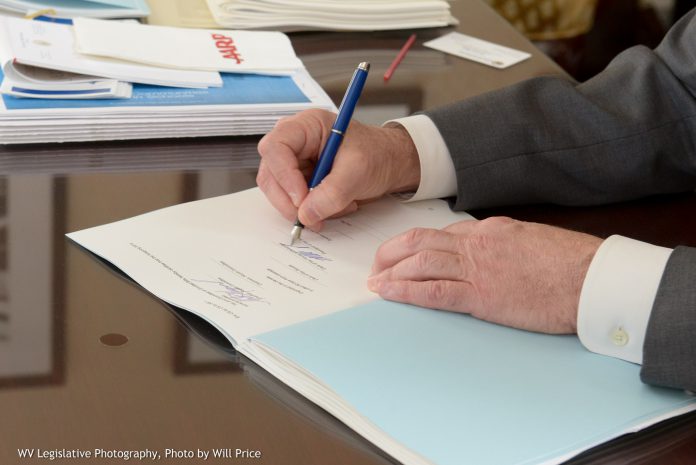Each legislative session approximately 2,000 bills are introduced in the Legislature, with 200-300 passing both legislative bodies. From introduction to passage, the process of developing a bill into a law can be quite stringent. Whether it is from years of schooling or from an educational legislative pamphlet, people have familiarized themselves with the process that surrounds bills passage. People may know how a bill becomes a law, but how does a bill become a bill? According to Ralph Kent, 32-year veteran of bill drafting, “It all starts with an idea.”
In the east wing of the main building of the Capitol Complex is the office of Bill Drafting and Legislative Services. Within the rooms of this office resides a staff consisting of attorneys, drafters, typists, proofreaders and support personnel that have the task of taking an idea and turning it into a bill.
“There ought to be a law,” is the common phrase that usually surrounds the ideas that make their way to Charleston. These ideas can come from anywhere and anyone. Whether you are a lobbyist, a constituent or a lawmaker, no idea is too big or too small. Once a goo d idea presents itself, the next stage is taking that concept and shaping it into legislation. The first step that needs to be taken in the bill drafting process is for the bill to have a legislative sponsor. Once there is a sponsor attached to a bill, a draft request form must be submitted. From this form, attorneys use the information provided to find a place for the idea in the West Virginia Code under such sections as crime, taxes or education.
d idea presents itself, the next stage is taking that concept and shaping it into legislation. The first step that needs to be taken in the bill drafting process is for the bill to have a legislative sponsor. Once there is a sponsor attached to a bill, a draft request form must be submitted. From this form, attorneys use the information provided to find a place for the idea in the West Virginia Code under such sections as crime, taxes or education.
Sometimes the leg work of sifting through the West Virginia Code to find the proper place for a bill is a difficult task for the bill drafting attorneys. Other times, their job can be made a little easier. According to Randy Elkins, assistant director of Legislative Services, “Technology has greatly aided in the bill drafting process.”
Not only does the internet save countless trips to law libraries, but now lawmakers, attorneys and everyday citizens have the ability to research bills presented and passed by other states. With this tool at their fingertips, bill drafters and lawmakers are able to seek out similar legislation from other states, where the legal and technical jargon is already in bill form, and find where it fits in the West Virginia Code. Bill drafting could be the only style of writing where plagiarism is acceptable.
Bills created in the bill drafting office range in length, with the majority averaging five to seven pages. These bills work to repeal, amend, and/or reenact the West Virginia Code. Bills drafted can encompass a number of ideas, ranging from educational issues to changing the state tax code.
Many bills drafted, especially those that deal with government agencies, if passed, would require funding to put the legislation into action. These bills, before being introduced, must contain a fiscal note. Fiscal notes indicate the financial impact for the fiscal year, showing how the proposed bill will affect revenue or expenditures of the State and local governments. Fiscal notes help lawmakers understand the impact of bills being considered, so they may better serve their district and constituents. The preparation of a fiscal note may also identify ramifications previously unknown to the sponsor of the legislation. Fiscal notes have the ability to make or break a bill. Once a draft request has been submitted, agencies have three days to submit the fiscal note. Finance committees won’t even entertain a bill if a fiscal note is not included in the draft.
Once the bill is drafted, it makes its way to the proofreaders where it’s read, re-read, and then read yet again to ensure accuracy of language, spelling, and punctuation. This could be a long process that has the bill being sent back and forth between the proofreaders and typists a number of times before finally receiving approval from the Director of Legislative Services, John Homburg.
Once approved by the director or assistant director, the drafted bill is sent to the bill’s originating sponsor. Upon the legislator’s approval, the bill is sent to the clerk of the corresponding house to be introduced on the floor, where the process of turning a bill into a law begins.
What’s New on the West Virginia Legislature’s Website
The online West Virginia Code has been enhanced to show bills that have become law (under the chapter of the code affected) but have yet to be incorporated in the online version.
https://www.wvlegislature.gov/WVCODE/Code.cfm
Bill Tracking has been improved to allow users the ability to prioritize bills and add personal notes. Users can also now sort and view their bills by multiple criteria.
https://www.wvlegislature.gov/billstatus_personalized/persbills_login.cfm
On the Bill History page, sponsors, subjects and code affected are now all hyperlinked to related bills. It is now possible to sort bills by date, step, status or committee, and direct links to the history and text of the bills is now available. The effective date of bills that have become law has also been added.
https://www.wvlegislature.gov/Bill_Status/bill_status.cfm
The new legislative blog Today in the Legislature is a daily synopsis of legislative floor activities, complete with photos and daily committee meeting schedules.
https://www.wvlegislature.gov/daily_sum/today.cfm
Visit the Legislature’s Homepage: https://www.wvlegislature.gov

